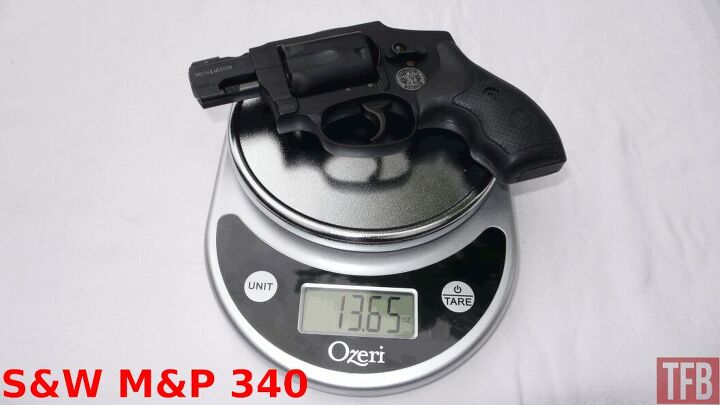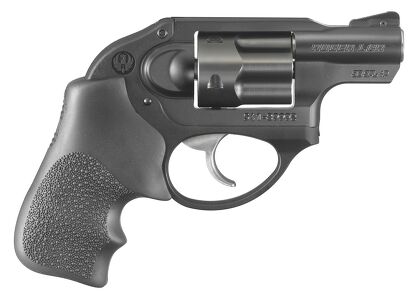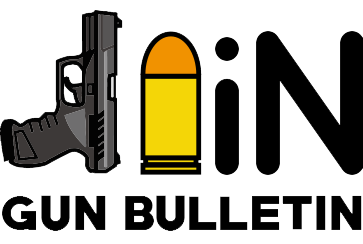Revolvers have been a hot commodity since they first came to market in the 1830s and they don’t show signs of waning in popularity anytime soon. If you are interested in carrying a revolver, it’s important to know what to look for and which related accessories will assist you in learning to use it efficiently. In our Best Concealed Carry Revolver guide, we’ll cover the top 5 concealed carry revolvers, considerations on calibers, capacity, and pricing, along with some helpful tips and essential accessories for first-time revolver owners.

More Concealed Carry Articles @ TFB:
Factors To Consider When Choosing A Concealed Carry Revolver
What Caliber Should I Choose?
When looking at revolvers for concealed carry, the first thing I think about is what caliber I’d like to carry. Perhaps you’ve heard great things about X, Y, or Z calibers and you think you’d like to explore those revolver calibers with the goal of protecting yourself and your loved ones. If you read TFB’s Wheelgun Wednesday from time to time, you may recall I actually counted the number of revolver cartridges currently available, which amounts to 57 revolver calibers. Not all of those calibers will translate into concealed carry, but there are a good amount of options, to say the least. The most popular revolver calibers for concealed carry are:
Optimal Size and Weight
Another top consideration for choosing a concealed carry revolver is what size and weight you can get away with without broadcasting to the world that you’re carrying a handgun. Even though the smallest of revolver cylinders are wider than semi-auto pistols, that width is far enough forward on the revolver that the belt line seems to hide it easier. However, depending on the wheelgun’s material and size, they can be heavier than semi-auto pistols. For example, a Glock 19 weighs 21.16 ounces unloaded, while the Ruger SP101 with a two-inch barrel weighs 25 ounces.

Capacity
When it comes to concealed carry, there are always trade-offs, and ammunition capacity is certainly one of the balance points that wheel gunners are accustomed to. Using our previous example of the Glock 19 vs. the Ruger SP101, the Glock’s standard capacity is 15 rounds, with the option to use 17, 24, and 33-round magazines, while the Ruger’s capacity is fixed at 5 rounds (for the .357 Mag, .38 Spl, and 9mm versions). A lot of people choose to carry handguns with more capacity, but for others, weighing the probability of need, comfort, concealability, and simplicity of use has them choosing a revolver.

Reliability with Caveats
The term “reliable” has become nearly synonymous with the word “revolver” over the years, which is true, with some big caveats. Revolvers are extremely straightforward to unload, load, and shoot, which is one of the reasons why they’re so popular. However, becoming efficient and accurate takes practice. Everyone wants a reliable gun, so taking care not to abuse the cylinder, crane, and ejector rod are three caveats to being able to call your revolver “ol’ reliable” for decades. Spinning the cylinder and flipping it closed are counterproductive in the reliability category over time as it loosens needed tight tolerances such as the cylinder stop and cylinder stop notches.

Comfort
Comfort under recoil versus comfort while carrying may be two different issues, but they don’t always have to be. Finding the right blend between grip shape and material and having a well-made holster and sturdy belt can be the key to comfortable concealed carry. Also finding the right on-body placement of the holster for your body shape and wardrobe are things you’ll want to try, as well as looking up what has worked for others.
Pricing
Our best concealed carry revolver list ranges in price from $393 to $1299 so we’ve considered something attainable for almost every budget. However, the extreme price differences are much wilder than our Top 5 list below. The lowest price of any current production revolver is the Rock Island Armscor M206 which has an MSRP of $259, while the most expensive concealed carry revolver, the Spohr Club Edition 3.0 tops out at $5,349! Thus, like with most things, revolvers can be had within any price range. As mentioned above, after I decide which caliber I’d like to carry, the next step is determining a target budget to help me decide what model and features I can afford. Aftermarket support should be considered for the cost and availability of accessories like holsters, as well as potential upgrades.
The Top 5 Best Concealed Carry Revolvers
Ruger LCR
The Ruger LCR is a solid choice for concealed carry due to its light weight, reliability, and many caliber options. The LCR’s overall weight is reduced thanks to polymer housing around its metal frame and by sporting a heavily fluted cylinder. Ruger has two designations; the LCR, and the LCRx. The standard LCR is double action only (DAO) and features a 2-inch barrel and a fixed rear sight, while the LCRx models have an exposed hammer for double action and single action (DA/SA). The LCRx also comes with 2 or 3-inch barrels, an adjustable rear sight, and a longer grip. Between the two styles, the Ruger LCR is offered in six calibers; .22LR, .22WMR, .327 Fed Mag, 9mm Luger, .38 Spl +P, and .357 Mag.

Pros and Cons of the Ruger LCR
The Ruger LCR’s weight and reliability are its most notable advantages, but there are also different factory and aftermarket grip styles available and the front sight blade can be swapped to meet the user’s preference as well. For someone looking to get their first concealed carry revolver, having the option between six different calibers to decide from is a big bonus from Ruger. The .22LR version provides the largest capacity with 8 chambers, while the .22 WMR and .327 Fed Mag versions have a capacity of 6 rounds. The 9mm, .38 Spl and .357 Mag models are limited to a 5-round capacity, which is standard for the frame and cylinder size.

There are two drawbacks to the Ruger LCR; one of which is the price for those on a tighter budget. With its MSRP ranging from $739 to $859, the Ruger LCR and LCRx are in the middle of the pricing pack for this top five list. The other downside strictly relates to the standard LCR with its double action only. To be fair, DAO is perfectly acceptable for self-defense and it forces the user to train with the long trigger pull, but I also like the option of single action if I’m just plinking at small targets for fun. The exposed hammer of the Ruger LCRx offers that versatility.

Specs:
(LCR, 2 INCH, .357 MAGNUM)
- GRIP Hogue® Tamer™ Monogrip®
- FRONT SIGHT Replaceable, Pinned Ramp
- BARREL LENGTH 1.87″
- CYLINDER FINISH PVD
- TWIST 1:16″ RH
- REAR SIGHT U-Notch Integral
- FINISH Matte Black
- WEIGHT 17.1 oz.
- HEIGHT 4.50″
- OVERALL LENGTH 6.50″
- CAPACITY 5
- GROOVES 6
- AVAILABLE IN CA Yes
- AVAILABLE IN MA Yes
Ruger LCR

Taurus 856
The Model 856 is one of Taurus’ flagship concealed-carry revolvers, and it’s gotten some special treatment offerings in the last few years. The Taurus 856 is chambered for .38 Special +P with a capacity of six rounds. There are seven different versions of the 856; Ultra-lite, Executive, Defender, Defender T.O.R.O. (optics ready), Concealed Hammer, Massachusetts Compliant, and California Compliant. The Executive, Defender, and Defender T.O.R.O. models come with 3-inch barrels, while the rest of the 856 line comes standard with a 2-inch barrel.

Pros and Cons of the Taurus 856
The biggest advantage of the Taurus 856 is having a six-round capacity, as well as having numerous versions to choose from. Another advantage is that Taurus offers several different grips from the factory, but a slew of aftermarket grip panels can also be found for sale online. I was very impressed to see that Taurus offers a replaceable front night sight for the Model 856 for only $29.99 (at the time of this writing). Speaking of affordability, the Taurus 856’s MSRPs range from only $393.99 to $499.99, which makes it the most affordable concealed-carry revolver on this list.

I reviewed the Taurus 856 T.O.R.O. model for TFB’s Wheelgun Wednesday and I was extremely impressed. I bought my review sample and have carried it with and without an optic.

The only downside to the Taurus 856 is that it’s only available in .38 Special +P. That’s not to say that the .38 +P isn’t a potent self-defense cartridge, but you’ll have to decide if the .38 Special in standard or +P pressures is your go-to cartridge for self-defense before choosing the Taurus 856. The Taurus brand does have its nay-sayers due to quality control issues in years past and lemons still exist for most manufacturers, however, in my numerous samples over the last five years, each Taurus revolver I’ve reviewed has been flawless.

Specs:
- CALIBER 38 SPECIAL +P
- CAPACITY 6 Rounds
- FRONT SIGHT Removable Serrated Blade
- REAR SIGHT Fixed
- ACTION TYPE DA/SA
- FRAME SIZE Small
- BARREL LENGTH 2.00 In.
- OVERALL LENGTH 6.55 In.
- OVERALL HEIGHT 4.80 In.
- OVERALL WIDTH 1.41 In.
- OVERALL WEIGHT 16.00 Oz. (Unloaded)
- TWIST RATE 1:16.5-in RH Twist
- GROVES 6
- FRAME MATERIAL Aluminum
- FRAME FINISH Cerakote
- CYLINDER MATERIAL Alloy Steel
- CYLINDER FINISH Matte Black
- BARREL MATERIAL Carbon Steel
- BARREL FINISH Cerakote
Taurus 856

Ruger SP101
Ruger is known for making bomb-proof revolvers, which include the small framed SP101 line. The beefier characteristics can be seen in its weight, which varies between 25 and 29.5 ounces, making it the second heaviest option for the best concealed carry revolver list.

It comes in several different configurations and calibers. Ruger offers the SP101 with 2.25 and 3-inch barrels with fixed rear sights and a swappable front sight ramp, while the 4.20-inch barreled models come with adjustable rear sights. All but one offering of the Ruger SP101 comes with an external hammer spur for DA/SA use. The SP101 is available in .22LR, .327 Fed Mag, 9mm Luger, .38 Spl +P, and .357 Mag. The latter three calibers have a 5-round capacity, whereas the .327 Fed Mag version carries 6 rounds, and the .22LR model has an 8-round capacity. The Ruger SP101 comes with the iconic rubber overmolded grips with wood or plastic side panels. There are also aftermarket grips and grip panels for personalizing your SP101.

Pros and Cons of the Ruger SP101
I carried a 3-inch .357 Magnum SP101 every day for just over a decade, and despite its heft, it carried comfortably and concealed perfectly inside my waistband at my 4 o’clock position. I eventually replaced the front sight ramp with an aftermarket night sight, and I also got a set of replacement grip panels. One of the great advantages of the Ruger design is that the internal parts are easily field-stripped for maintenance.
The black factory front sight ramp contrasts the stainless rear sight notch, but some fingernail polish could help with its visibility. With current pricing, the Ruger SP101 is a bit of a spicy meatball to swallow with $919 to $979 MSRPs, making it the second most expensive wheelgun on our list.

Specs:
(2.25 INCH, .357 MAGNUM)
- GRIPS Black Rubber, Black Synthetic
- FRONT SIGHT Black Ramp
- BARREL LENGTH 2.25″
- MATERIALStainless Steel
- CAPACITY 5
- REAR SIGHT Integral
- TWIST 1:16″ RH
- FINISH Satin Stainless
- OVERALL LENGTH 7.20″
- WEIGHT 26 oz.
- GROOVES 5
- AVAILABLE IN CA Yes
- AVAILABLE IN MA Yes
Ruger SP101

Smith & Wesson 642
The Smith & Wesson 642 is a double-action only, airweight wheelgun that is built strictly for self-defense and concealed carry. The Model 642 essentially has everything you need and nothing you don’t. It has a concealed hammer which is what makes it double-action only. The S&W 642 is built on the J Frame size revolver that fits 5 rounds of .38 special in the cylinder.

Pros and Cons of the S&W 642
The Smith & Wesson 642’s main advantage is that it’s one of the most affordable wheelguns from a long-standing revolver manufacturer with an MSRP of $539, which also makes it the second most affordable revolver on this list. Another boon for the 642 is that this model comes without the controversial integral lock. If you have not appreciated or trusted that function on S&W’s other revolvers, then you won’t have to worry about it on the S&W 642. Being an Airweight model, S&W states that the 642 weighs in at 14.4 ounces for easier pocket carry, or just not weighing down your belt all day.

Part of the reason the 642 is so affordable is also one of its downsides in that the front sight is completely fixed and can’t be replaced with other options. I’ve used bright fingernail polish on fixed front sight ramps before, so there’s a cheap hack if you’re looking for one. There are at least a plethora of factory and aftermarket grips available, but that’s the only thing on the S&W 642 that you can change. Another tick against the S&W 642 is that it is limited to one caliber, .38 Special; no +P, just standard .38 Special. Again, this isn’t a complete knock on the venerable .38, but if you want more caliber options you may want to look at Smith & Wesson’s other J-Frame models, of which there are plenty. As an honorable mention, I would also recommend the S&W M&P 340 that I reviewed a while back.

Specs:
- WIDTH 1.3 in
- LENGTH 6.31 in
- HEIGHT 4.3 in
- WEIGHT 14.4 oz
- CALIBER 38 S&W SPECIAL
- SIZE SMALL
- CAPACITY 5
- ACTION DOUBLE ACTION ONLY
- BARREL LENGTH 1.88
- GRIP SYNTHETIC
- SIGHTS INTEGRAL
- OPTIC READY NO
- SAFETY NONE
- COLOR/FINISH SILVER
- STATE COMPLIANCE CA, CO, CT, DE, HI, IL, MD, MA, NJ, NY, OR, RI, VT, WA
- THREADED BARREL NO
- BARREL MATERIAL STAINLESS STEEL
- FRAME ALUMINUM
- LASER NO
- 10LB TRIGGER YES
Smith & Wesson 642

Smith & Wesson 19 Carry Comp
The S&W 19 Carry Comp is a reworked version of the larger K Framed Model 19 that typically sported larger grips and a 3- to 6-inch barrel. This new vision for the 19 Carry Comp comes with a 2.5- or 3-inch barrel, both versions of which feature a compensator port between the muzzle and the front sight that vents gas upward to reduce muzzle climb. This factory-made trend has caught on with semi-auto pistols of late as well. The S&W 19 Carry Comp is chambered for 6 rounds of .357 Magnum.

The Pros and Cons of the S&W 19 Carry Comp
The Model 19 Carry Comp has several advantages and disadvantages. If you’ve read this far, you can probably guess that I’m a fan of having six rounds over five, and the 19 Carry Comp obliges in this regard, on top of being chambered for .357 Magnum which means you can also shoot .38 Spl and .38 Spl +P. It also ships with two grips, a fancy-looking two-fingered wood grip, and a slightly longer rubber grip which I preferred, especially with full house .357 loads. I found that the compensator did help me get back on target quicker. I loved that the front sight blade came with a night sight installed from the factory and that the rear sight was adjustable.

The S&W 19 Carry Comp’s weight is a double-edged sword. It’s the weightiest revolver on our list at 33 ounces, which may weigh your belt down a bit, but that extra heft also helps with recoil mitigation. The cost of the 19 Carry Comp is its biggest detractor, having an MSRP of $1269 for the 2.5-inch barrel and $1299 for the 3-inch version.

Specs:
- WIDTH 1.45 in
- LENGTH 8 in
- HEIGHT 5.85 in
- WEIGHT 34.5 oz
- CALIBER 357 MAGNUM
- SIZE MEDIUM
- CAPACITY 6
- ACTION SINGLE/DOUBLE ACTION
- BARREL LENGTH 3
- GRIP WOOD/SYNTHETIC
- SIGHTS NIGHT SIGHTS
- OPTIC READY NO
- SAFETY NONE
- COLOR/FINISH BLACK
- STATE COMPLIANCE CA, CO, CT, DE, HI, IL, MD, MA, NJ, NY, OR, RI, VT, WA
- THREADED BARREL NO
- BARREL MATERIAL STAINLESS STEEL
- FRAME CARBON STEEL
- LASER NO
- 10LB TRIGGER YES
Smith & Wesson Model 19 Carry Comp

Quick Comparison of the Top 5 Best Concealed Carry Revolvers
|
Weight (oz) |
Calibers |
Capacity |
Price |
Special Features |
|
|
Ruger LCR |
13.5 – 21.3 |
6 |
5, 6, 8 |
$739 – $859 |
Low weight, different calibers and configurations |
|
Taurus 856 |
16 – 25.52 |
1 |
6 |
$393.99 – 499.99 |
Six different configurations, including Optics Ready |
|
Ruger SP101 |
25 – 29.5 |
5 |
5, 6, 8 |
$919 – $979 |
Solidly built, multiple calibers and configurations |
|
S&W 642 |
14.4 |
1 |
5 |
$539 |
Concealed hammer, low weight |
|
S&W 19 Carry Comp |
33 – 34.5 |
2 |
6 |
$1269 – $1299 |
Integral compensator, front night sight, two grips |
How to Choose the Right Concealed Carry Revolver
Choose the Better Capacity When Able
If you are considering purchasing a revolver for concealed carry, I like to get the largest capacity my wardrobe and body type will let me conceal. When it comes to inside-the-waistband carry (IWB), I’ve found that my 5’10”, 195-pound frame can conceal a seven-shot .357 Magnum revolver under a large t-shirt, but I’ve found that six-shot revolvers are just right for me and I can even conceal them under a tucked shirt as well.
Enlist Trusted Revolver Owners and Firearm Dealers
Finding what works for you may become a bit of guesswork if you don’t have access to concealed-carry revolvers to try before you buy. If you have a trusted friend, family member, or a firearms dealer, they should be willing to help you find what works, but big-box stores may be a bit leery to let you start tucking guns in your pants, and they may not have experienced shooters to give solid advice. Back to enlisting friends and family, if they have some revolvers you could shoot before buying your own, that would be the best to figure out if a revolver is right for you.

Holsters for Your Concealed Carry Revolver
On-body carry is the best and safest place to carry any defensive handgun. Fortunately, there are plenty of options to help you do that. In my Best Glock 19 Holsters article, I broke down the wide variety of holster styles; Outside the Waistband ( OWB), Inside the Waistband ( IWB), Appendix Inside the Waistband ( AIWB), Shoulder Holsters, and Ankle Holsters should all have some extra wiggle room to work with your style of dress and body type.
For the women in the audience, I also highly recommend checking out YouTube’s female concealed carry advocates’ channels and see what has worked for them. Purse carry is a thing, but retrieving a handgun from a purse will take practice, and its orientation will change if you switch shoulders, especially if it’s placed in a larger compartment with other things.

Final Costs
Once you’ve settled on which revolver you’ll buy, your carry method, and holster, you’re almost there.
The next thing on the list is to acquire some self-defense ammunition and some practice ammo. Just to clarify for the people starting from zero, self-defense ammo means hollow point bullets, or a filled cavity hollow point such as Hornady’s Critical Defense. This type of bullet is designed to expand in tissue so that it dumps all of its energy in an assailant, rather than over-penetrating into an unintended bystander.

Buying cheaper practice ammo will let you practice your trigger control while keeping your sights on target. It will also get you accustomed to reloading your concealed-carry revolver. Another vital cost and consideration is how you plan to reload. In the case of 9mm or .45 ACP, you need moonclips. However, with rimmed cartridges like .38 Special, .357 Magnum, or .44 Magnum, there are several different methods to quickly facilitate reloading; such as speed loaders and speed strips. The good news is that the aforementioned reloading devices can all be had for under $20. Reloading with loose cartridges is free, but costs a lot of time for a self-defense situation. I’ve written in-depth articles on each of those reloading methods which you can read by following the links directly above.

The final cost would be a cleaning kit. Revolvers aren’t too hard to care for, but using a brass brush through the barrel and cylinder chambers can help keep your revolver reliable and ready for use at a moment’s notice. If you carry your concealed carry revolver against your body, you may drip some sweat on it from time to time, so keeping a light coat of oil on the external parts will also help keep it looking good. You can also use compressed air to blow out any lint.
Conclusion
Thanks for joining us on this deep dive into the Best Concealed Carry Revolvers. Even if you decide on something different than the Top 5 above, I hope this has been helpful in finding features and specifications that suit you. Revolvers are here to stay, but when possible, try some wheelguns out first to make sure they’re right for you. Even though revolvers are tough and reliable, keeping them clean and handling them properly is key to their ongoing success.
We want to hear your feedback in the comment section. If you are considering getting a concealed carry revolver, does one of our top 5 catch your eye? If you’ve already been carrying one of our top 5 listed above, which one is it and how has your experience been? What would your top 5 be and why?
We are committed to finding, researching, and recommending the best products. We earn commissions from purchases you make using the retail links in our product reviews. Learn more about how this works.


